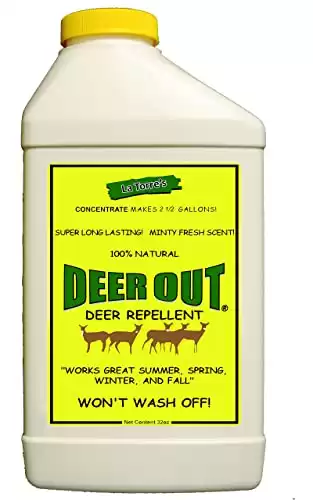Deer are hoofed animals that live in forests, prairies, savannas, and transitional spaces between these landscapes. Technically reindeer, elk, and moose are types of deer. But, when many people think of deer they think of a Bambi-like species, like the white-tailed deer, the red deer, or the mule deer. Deer species are naturally found on every continent except Antarctica and Australia.
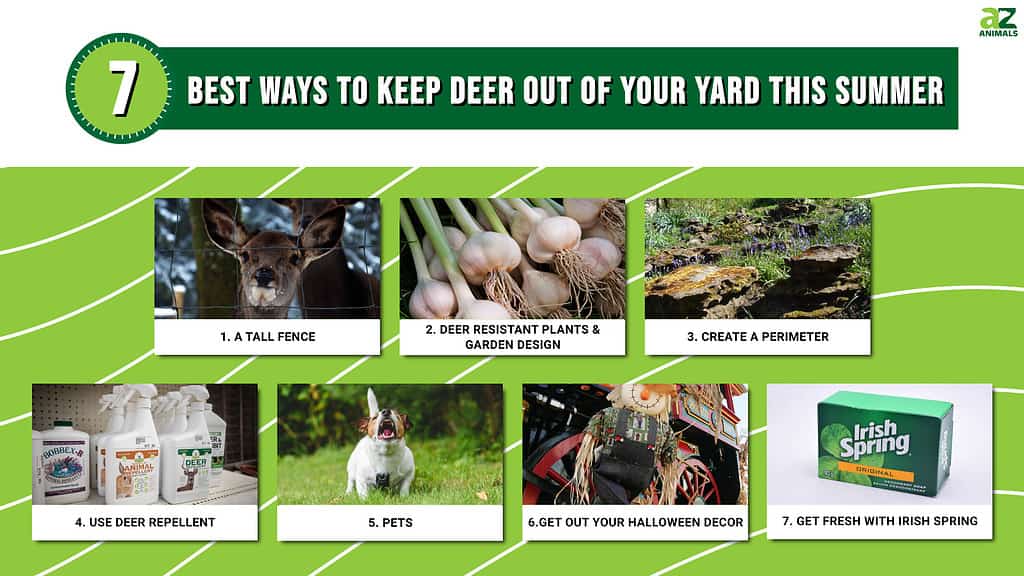
These foraging animals love to eat weeds, specific crops, and flowers. Yards and gardens sometimes pose an attractive meal to deer, especially in areas where homes are closer to their natural habitats. However, they can destroy your hard work. So, how do you keep deer from eating all of your plants in the summer?
1. A Tall Fence

Experts suggest an 8 to 12-foot fence for keeping deer out of your yard.
©Mirjam Claus/Shutterstock.com
Installing a tall fence is a nearly foolproof way to keep deer out of your yard in any season. However, the standard fence height of six feet is not enough to stop a hungry deer. Experts recommend constructing a fence that is at least eight feet high, and suggest that a 12-foot tall fence is sure to keep deer at bay if the fence style is see-through. When deer can see all the yummy snacks your yard has for them, they are more likely to try harder to get in.
If you already have a six-foot tall fence in a see-through style, and you don’t want to get a new one, you could put barbed wire or electrified fencing on top of the fence. However, some people don’t like that from an aesthetic perspective. Another alternative is to add planters to the top of the fence to increase the height.
If you have a fence style that is not see-through, then six feet is a great height to keep deer out.
Alternatively, you could put up a shorter double fence. These are two sets of fences that sit between three and five feet apart. Following the same idea, you can plant shrubs right next to your fence to reinforce it and increase the distance a deer would need to jump. Deer are less likely to jump over a wider distance, especially if they’re not sure if they can stick the landing.
2. Deer Resistant Plants & Garden Design
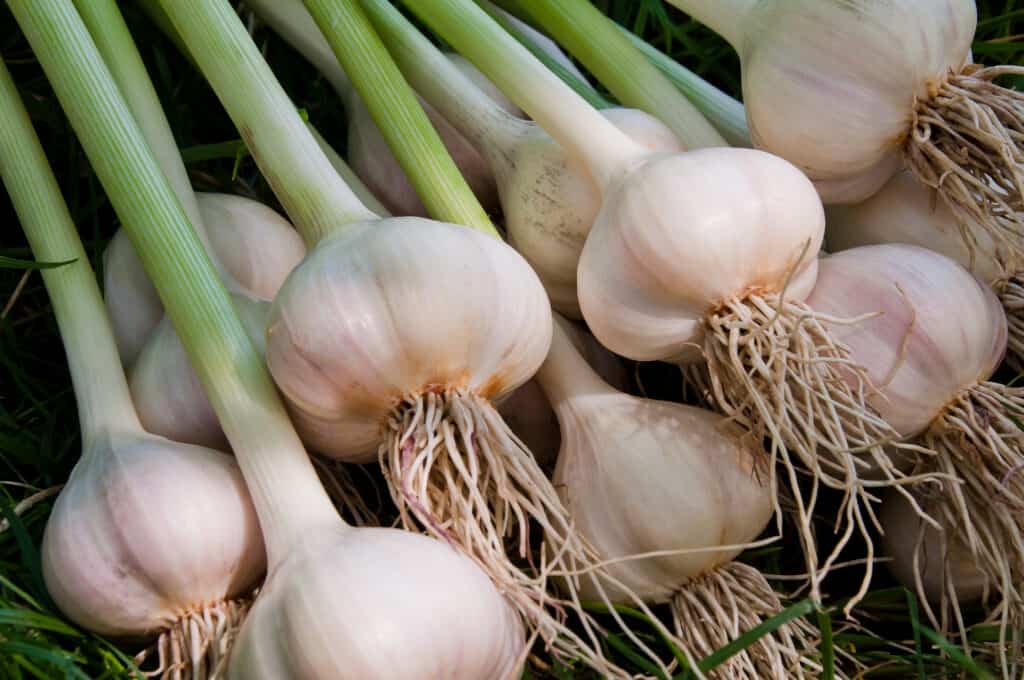
Some plants, like rosemary and garlic, are unpleasant to deer.
©Liubomyr Tryhubyshyn/Shutterstock.com
Deer are not that picky when it comes to plants, but there are a few options that might turn them off from your garden. The only plants that deer will completely avoid are those that are poisonous to them. Lupine, daffodils, foxglove, and tulips are just a few plants that you can incorporate into your garden that deer will not eat. If you do use toxic plants, make sure they are not toxic to any of your pets that may go in the garden.
There are other types of plants that deer might munch on but they don’t enjoy them as much. For example, they don’t like messy plants that have a lot of sap. They also have a distaste for plants that have a strong scent like rosemary and garlic. If something is hard or unpleasant to eat, they will avoid that too. So plants with thorns, brambles, furry leaves, or a rough texture, will be a deer deterrent.
You probably don’t want to make a garden of only deer-resistant plants, so you have to use them in a smart design. There are a couple of options for this:
- Plant large amounts of deer-resistant plants. They may eat a few, but they won’t get all of them!
- Create a thick barrier of deer-resistant plants around deer-friendly snacks. The barrier should be thick enough to make it hard for the deer to walk over it to the tastier treats.
Deer-resistant plants that you can use to deer-proof your garden include the following, but there are many more:
- Alliums like garlic, onions, shallots, scallions, leeks, or chives
- Lavender
- Rogusa roses
- Salvia
- Japanese maple trees
- American holly
- Thyme
- Mint
- Oregano
- Lemon balm
- California poppy
- Goldenrod
- Peony
- Yarrow
3. Create a Perimeter

©Kenneth Allen / CC BY-SA 2.0 – License
There are certain surfaces, like uneven rocks, that deer don’t like to walk on. Creating a rock garden perimeter around your yard can keep them out. If you have a fence, you can put the rock garden against the fence to remove any uneven landing surface. Without one, the deer will not be likely to try to jump into your yard.
4. Use Deer Repellent
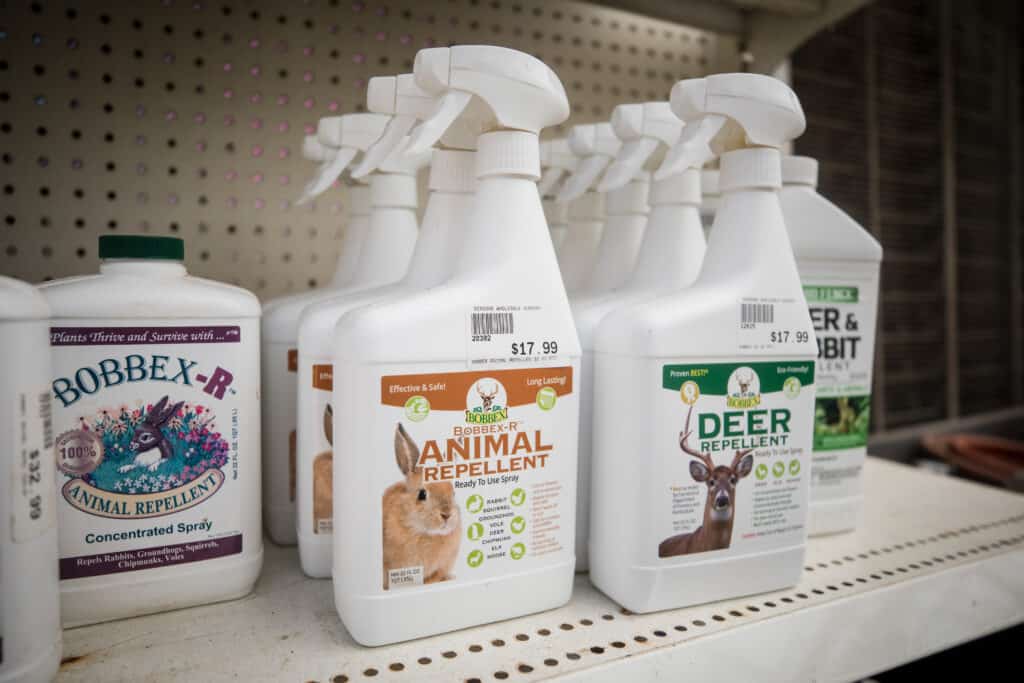
Deer repellent is available for purchase in many stores.
©Nicole Glass Photography/Shutterstock.com
Commercial deer repellents can help keep deer away. They usually come in spray form. Spray them on your plants, typically every few months. Unfortunately, these sprays do smell pretty bad at first, but the smell usually fades with time. If you use deer repellent spray, follow all the instructions on the packaging.
If you’re on a budget, some commercial deer repellents are basically just rotten eggs (hence why they smell so bad). Mix up some eggs with some water and spray it all over your garden to achieve a similar effect.
- Over 100,000 repeat customers!
- Humans love the minty-fresh fragrance, but wildlife doesn't
- Won't wash off in the rain or when you water your plants
- All-natural ingredients are environmentally safe
- 100% money-back guarantee
Other options for budget-friendly deer repellent include hair clippings from a local barber shop and manure from wild animals.
5. Pets

If you want to scare a deer right out of your yard, let your dog outside for some barking.
©alexei_tm/Shutterstock.com
If you have pets, especially dogs, let them go outside when a deer is near. Their barking may make even a hungry deer turn around and go right back where it came from. Cats are not as much of a deterrent, however, if you have a particularly bold cat who enjoys “hunting” large animals, they will learn their lesson to avoid your yard.
6. Get Out Your Halloween Decor
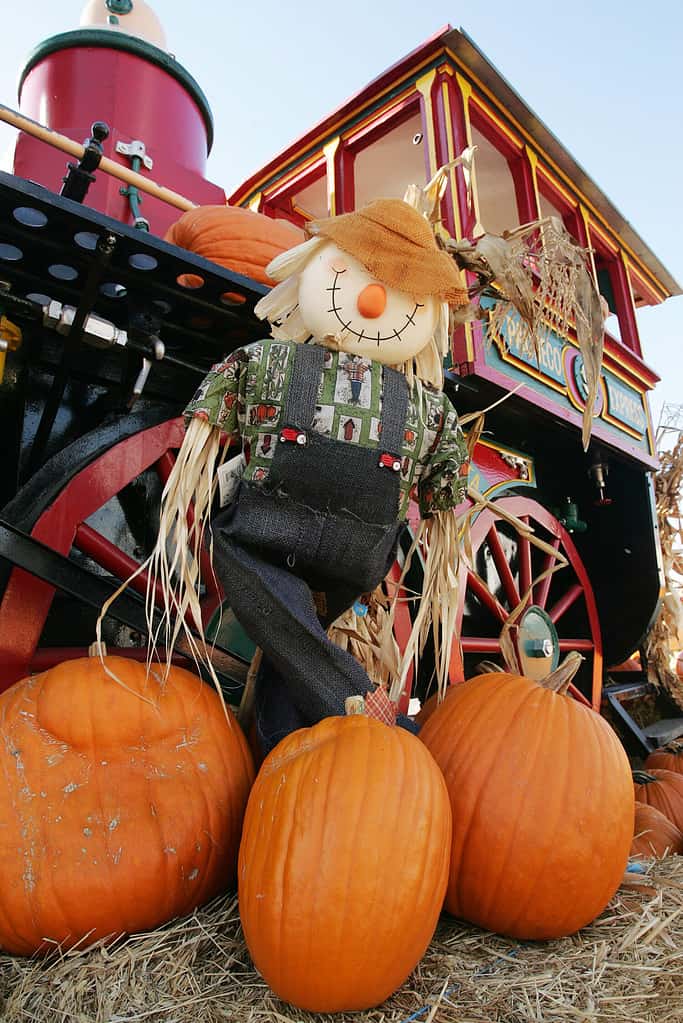
Scarecrows are among the fixtures you could put on your property to startle deer.
©Robert H. Creigh/Shutterstock.com
Deer are decidedly not scary movie fans. They spook pretty easily. Using a motion detector rigged up with Halloween decorations, a sprinkler, a scarecrow, or bright lights can send deer running. Make sure to change up the deterrents once in a while. Deer may become accustomed to your scarecrow and start to consider it more of a friend instead of a foe.
7. Get Fresh With Irish Spring
Many animals, including deer, hate the scent of Irish Spring soap. If you go with this method, make sure to get the original scented bar of soap. The brand has plenty of other products but nothing works as well as the original. Try these methods to use Irish Spring as a deer deterrent:
- Hang a bar in a mesh bag. The hanging mesh bag will cover a space of 10 feet by 10 feet. Hang it at the height of a deer’s head and place the bags closest to the plants’ deer like the best. The best option is to use garden stakes to hang the soap.
- Instead of using a mesh bag, drill a hole in the center of a bar of soap and use a rope or string to hang it up in your garden.
- Use a knife or peeler tool to create soap shavings and sprinkle them all over your garden. Put them closest to your most deer-friendly plants.
Whichever method you choose, replace the soap after a rain, after it dissolves, or every few weeks, whichever occurs first.
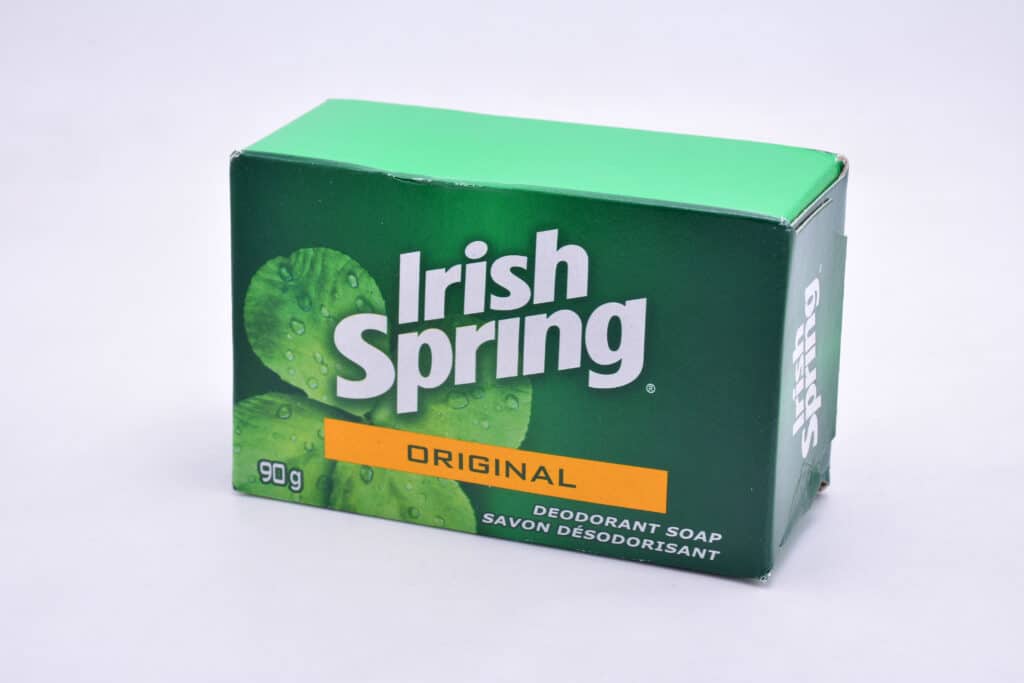
For whatever reason, deer really hate the smell of Irish Spring soap.
©Walter Eric Sy/Shutterstock.com
Experts are not sure exactly what it is about Irish Spring that keeps the deer at bay, but they do know it is an affordable option that really works.
Summary Of The7 Best Ways To Keep Deer Out Of Your Yard This Summer
| Best Way To Repel Deer | |
|---|---|
| 1 | A Tall Fence |
| 2 | Use Deer Resistant Plants in your Garden Design |
| 3 | Create a Perimeter |
| 4 | Deer Repellent |
| 5 | Pets |
| 6 | Halloween Decor |
| 7 | Irish Spring |
The photo featured at the top of this post is © Lester Graham/Shutterstock.com
FAQs (Frequently Asked Questions)
How Do You Keep Deer Out of Your Yard?
1. A Tall Fence
Installing a tall fence is a nearly foolproof way to keep deer out of your yard in any season. However, the standard fence height of six feet is not enough to stop a hungry deer. Experts recommend constructing a fence that is at least eight feet high, and suggest that a 12-foot tall fence is sure to keep deer at bay if the fence style is see-through. When deer can see all the yummy snacks your yard has for them, they are more likely to try harder to get in.
If you already have a six-foot tall fence in a see-through style, and you don’t want to get a new one, you could put barbed wire or electrified fencing on top of the fence. However, some people don’t like that from an aesthetic perspective. Another alternative is to add planters to the top of the fence to increase the height.
If you have a fence style that is not see-through, then six feet is a great height to keep deer out.
Alternatively, you could put up a shorter double fence. This is two sets of fences that sit between three and five feet apart. Following the same idea, you can plant shrubs right next to your fence to reinforce it and increase the distance a deer would need to jump. Deer are less likely to jump over a wider distance, especially if they’re not sure if they can stick the landing.
2. Deer Resistant Plants & Garden Design
Deer are not that picky when it comes to plants, but there are a few options that might turn them off from your garden. The only plants that deer will completely avoid are those that are poisonous to them. Lupine, daffodils, foxglove, and tulips are just a few plants that you can incorporate into your garden that deer will not eat. If you do use toxic plants, make sure they are not toxic to any of your pets that may go in the garden.
There are other types of plants that deer might munch on but they don’t enjoy as much. For example, they don’t like messy plants that have a lot of sap. They also have a distaste for plants that have a strong scent like rosemary and garlic. If something is hard or unpleasant to eat, they will avoid that too. So plants with thorns, brambles, furry leaves, or a rough texture, will be a deer deterrent.
You probably don’t want to make a garden of only deer-resistant plants, so you have to use them in a smart design. There are a couple options for this:
- Plant large amounts of deer-resistant plants. They may eat a few, but they won’t get all of them!
- Create a thick barrier of deer-resistant plants around deer-friendly snacks. The barrier should be thick enough to make it hard for the deer to walk over it to the tastier treats.
Deer-resistant plants that you can use to deer-proof your garden include the following, but there are many more:
- Alliums like garlic, onions, shallots, scallions, leeks, or chives
- Lavender
- Rogusa roses
- Salvia
- Japanese maple trees
- American holly
- Thyme
- Mint
- Oregano
- Lemon balm
- California poppy
- Goldenrod
- Peony
- Yarrow
3. Create a Perimeter
There are certain surfaces, like uneven rocks, that deer don’t like to walk on. Creating a rock garden perimeter around your yard can keep them out. If you have a fence, you can put the rock garden against the fence to remove any uneven landing surface. Without one, the deer will not be likely to try to jump into your yard.
4. Use Deer Repellent
Commercial deer repellents can help keep deer away. They usually come in a spray form. Spray them on your plants, typically every few months. Unfortunately, these sprays do smell pretty bad at first, but the smell usually fades with time. If you use deer repellent spray, follow all the instructions on the packaging.
If you’re on a budget, some commercial deer repellents are basically just rotten eggs (hence why they smell so bad). Mix up some eggs with some water and spray it all over your garden to achieve a similar effect.
Other options for budget-friendly deer repellent include hair clippings from a local barber shop and manure from wild animals.
5. Pets
If you have pets, especially dogs, let them go outside when a deer is near. Their barking may make even a hungry deer turn around and go right back where it came from. Cats are not as much of a deterrent, however, if you have a particularly bold cat who enjoys “hunting” large animals, they will learn their lesson to avoid your yard.
6. Get Out Your Halloween Decor
Deer are decidedly not scary movie fans. They spook pretty easily. Using a motion detector rigged up with Halloween decorations, a sprinkler, a scarecrow, or bright lights can send deer running. Make sure to change up the deterrents once in a while. Deer may become accustomed to your scarecrow and start to consider it more of a friend instead of a foe.
7. Get Fresh With Irish Spring
Many animals, including deer, hate the scent of Irish Spring soap. If you go with this method, make sure to get the original scented bar of soap. The brand has plenty of other products but nothing works as well as the original. Try these methods to use Irish Spring as a deer deterrent:
- Hang a bar in a mesh bag. The hanging mesh bag will cover a space of 10 feet by 10 feet. Hang it at the height of a deer’s head and place the bags closest to the plants deer like the best. The best option is to use garden stakes to hang the soap.
- Instead of using a mesh bag, drill a hole in the center of a bar of soap and use a rope or string to hang it up in your garden.
- Use a knife or peeler tool to create soap shavings and sprinkle them all over your garden. Put them closest to your most deer-friendly plants.
Whichever method you choose, replace the soap after a rain, after it dissolves, or every few weeks, whichever occurs first.
Experts are not sure exactly what it is about Irish Spring that keeps the deer at bay, but they do know it is an affordable option that really works.
Thank you for reading! Have some feedback for us? Contact the AZ Animals editorial team.



